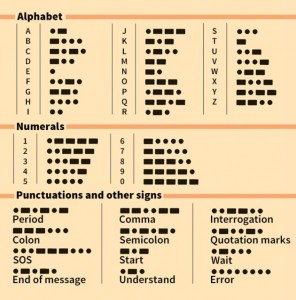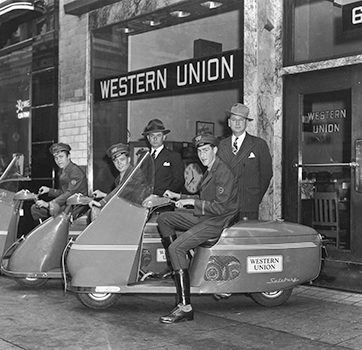Language Monday: Morse Code
Monday, March 19th, 2018March 19, 2018
…. .- .–. .–. -.– / — — -. -.. .- -.– Or dit-dit-dit-dit dit-dah dit-dah-dah dit-dah-dah dah-dit-dah-dah/dah-dah dah-dah-dah dah-dit dah-dit-dit dit-dah dah-dit-dah-dah. That’s Morse code for “Happy Monday!” In a way, you could say this was how one text messaged in the mid-1800’s! Morse code is a system of sending messages that uses short and long sounds combined in various ways to represent letters, numerals, and other characters. A short sound is called a dit. A long sound is called a dah.

Click to view larger image
International Morse Code uses short and long sounds, which are written out as dots and dashes. Credit: WORLD BOOK chart
The code is named for the American inventor and painter Samuel F. B. Morse, who, with Leonard Gale and Alfred Vail, patented the telegraph in 1840 in the United States. The credit for inventing the telegraph is also given to another set of researchers: Sir William Cooke and Sir Charles Wheatstone in the United Kingdom.
For use with the telegraph, Morse developed a code that assigned a set of dots and dashes to letters of the English language alphabet and allowed for the simple transmission of complex messages across telegraph lines. In 1843, Morse and Vail received funding from the U.S. Congress to set up and test their telegraph system between Washington, D.C., and nearby Baltimore, Maryland. On May 24, 1844, Morse sent the first telegraph message to Vail. It read, What hath God wrought?—a quote from the Book of Numbers in the Bible. This started the telecommunications revolution. By 1861, a telegraph line connected California with the eastern U.S. states, and a few years later, another crossed the Atlantic Ocean from the United States to Europe.
In those days, telegraph companies used American Morse Code to transmit telegrams by wire. An operator tapped out a message on a telegraph key, a switch that opened and closed an electric circuit. A receiving device at the other end of the circuit made clicking sounds and wrote dots and dashes on a paper tape. To understand the message, Morse code relies on precise intervals of time between dits and dahs (written as dots and dashes), between letters, and between words. Today, the telegraph and Morse code are used mostly in aerial and naval navigation.
International Morse Code was derived from American Morse Code for use by radio telegraphers. It is for all languages that use the Latin alphabet. Amateur and maritime radio operators still use this code regularly. Military and commercial operators may also use it when radio signals are too weak for other systems to work. In this code, a dah is three times as long as a dit. Between the sounds that represent a character, there is an interval of silence as long as one dit. Between letters are three such intervals; between words, there are seven. Other alphabet versions of Morse code include the Japanese Wabun Code and Korean SKATS.



